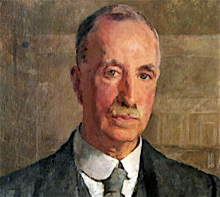
Frederick Moore Simpson was born in Hackney, Middlesex [now London], England on 25 November 1855. and was articled to George Frederick Bodley (1827-1907) from 1876 to 1880. He also attended the Royal Academy Schools in London from 1880 and was awarded a travelling studentship in 1884. He was also awarded the Arthur Cates Prize.
He worked as an assistant to Charles James Ferguson (1840-1904) from 1881 to 1883, and to Edward Robert Robson (1935-1917) in 1884. In 1885 he commenced independent practice as an architect in London and qualified as an architect in 1889. In 1890 he was elected an Associate of the Royal Institute of British Architects (ARIBA), and in 1902 a Fellow of the Royal Institute of British Architects (FRIBA). He was Professor of Architecture at the University of Liverpool from 1894 to 1903, and Professor of Architecture at the University of London from 1903 to 1919. In 1919 he was made Emeritus Professor at the University of London. From 1900 to 1902 he was President of the Liverpool Architectural Society. In 1922 he was appointed a Member of Commission on Trondhjem Cathedral by the Norwegian Government who made him a Knight, First Class of the Order of St. Olav.
Simpson exhibited regularly at the Royal Academy in London from 1885 to 1923. He also exhibited at the Royal Scottish Academy in Edinburgh in 1924; and in the 7th exhibition of the Arts & Crafts Exhibition Society at the New Gallery in London in 1903.
He was the author of 'A History of Architectural Development' (London: Longmans, 3 vols, 1905-1911); and various articles, papers, etc.
His address was given as 89 Chancery Lane, London in 1885; 9 Dean's Yard, Westminster, London in 1888 and 1890; 18 Cowley Street, Westminster, London in 1891 and 1892; 88 Gower Street, London (office) in 1914 and 1923; and 3 Brunswick Place, St. Marylebone, London in 1926. He died at The Ridge, Beconfield Road, Chelwood Gate, Danehill, Sussex on 13 June 1928
A biographical file on Frederick Moore Simpson is available on request from the Enquiry Desk, Royal Institute of British Architects Library, London
Works by Simpson included: At University College, London: — Institute of Physiology, 1908; Institute of Pharmacology, 1912; Chemistry Laboratory 1913; School of Architecture. 1914; Department of Eugenics and Applied Statistics, 1914; Department of Engineering, 1921 (the last three forming the Gower Street front); Department of Anatomy and Institute of Medical Sciences (Rockefeller Gift), 1923. School of Oriental Studies, Finsbury Circus and Eldon Street, E.C., 1916; Physics Laboratory, University College, Liverpool; Tropical Medicine, Blo-Chemistry, etc., University College, Liverpool; Queen Victoria Memorial, Liverpool (the last three in collaboration). Decorations: Town Hall, Liverpool; London Institution, Finsbury Circus; University College, London — Flaxman Gallery, etc. Various country houses [Source: Who's Who in Architecture 1923]
Armstrong, Barrie and Armstrong, Wendy. The Arts and Crafts movement in the North West of England: a handbook. Wetherby, England: Oblong Creative Ltd., 2006
Directory of British Architects 1834-1914. Compiled by Antonia Brodie, et al. Volume 2: L-Z. London; New York: British Architectural Library, Royal Institute of British Architects/Continuum, 2001
Gray, A. Stuart. Edwardian architecture: a biographical dictionary. London: Gerald Duckworth & Co., Ltd., 1985
Thistle, David. 'Modernism with Ancestry'. Architects' Journal vol. 201, no. 19, 11 May 1995 pp. 60-61
Who’s Who in Architecture 1923, edited by Frederick Chatterton. London: The Architectural Press, 1923
‘Obituary’. RIBA Journal vol. 35, 1928 p. 571
‘Obituary’. Architectural Review vol. 64, July 1928 p. lvi
‘Obituary’. The Builder vol. 134, 19 June 1928 pp. 1062, 1102